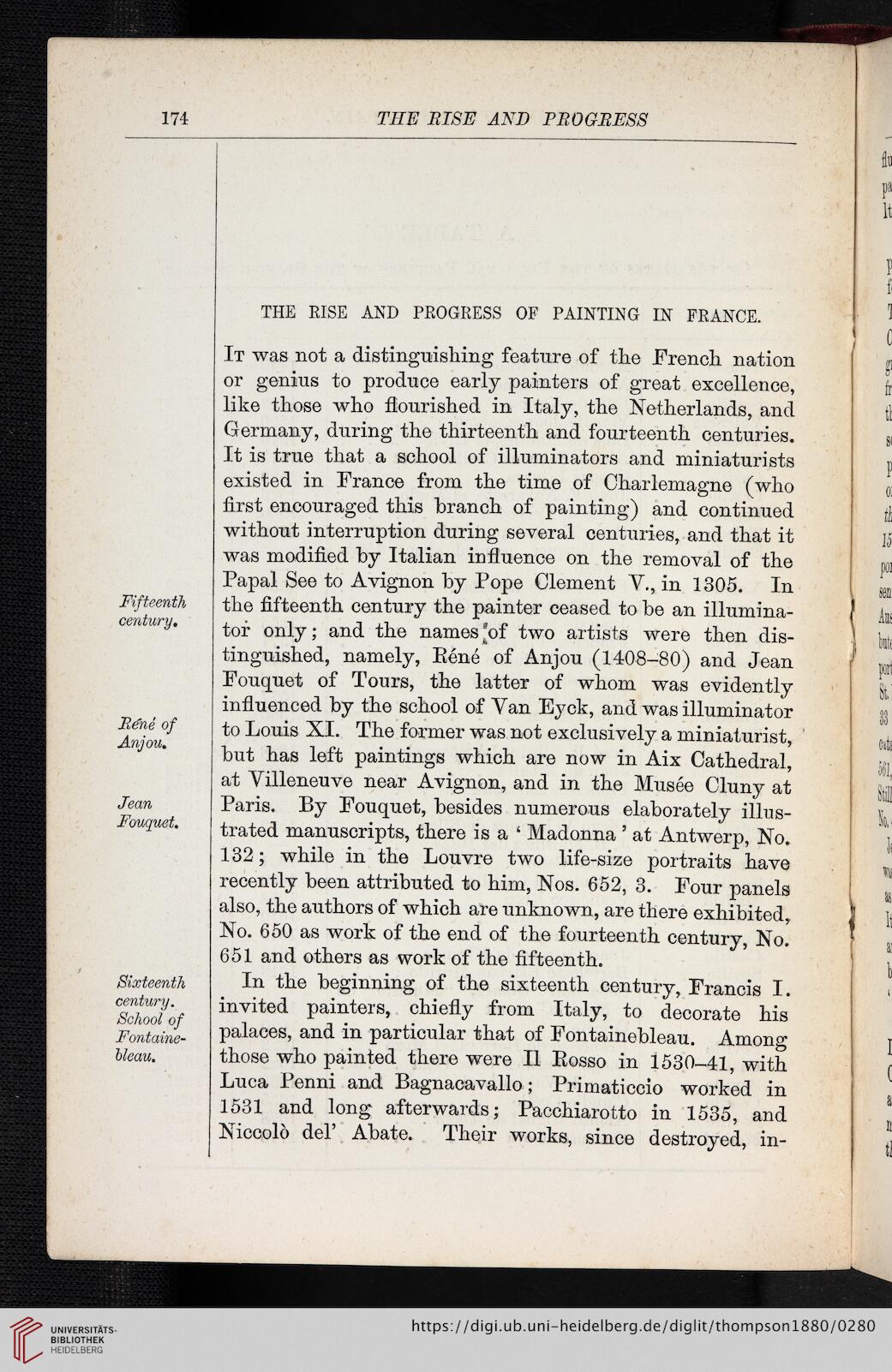174
THE RISE AND PROGRESS
THE RISE AND PROGRESS OF PAINTING IN FRANCE.
Fifteenth
century.
Rene of
Anjou.
Jean
Fouquet.
Sixteenth
century.
School of
Fontaine-
bleau.
It was not a distinguishing feature of the French nation
or genius to produce early painters of great excellence,
like those who flourished in Italy, the Netherlands, and
Germany, during the thirteenth and fourteenth centuries.
It is true that a school of illuminators and miniaturists
existed in France from the time of Charlemagne (who
first encouraged this branch of painting) and continued
without interruption during several centuries, and that it
was modified by Italian influence on the removal of the
Papal See to Avignon by Pope Clement V., in 1305. In
the fifteenth century the painter ceased to be an illumina-
tor only ; and the names [of two artists were then dis-
tinguished, namely, Rene of Anjou (1408-80) and Jean
Fouquet of Tours, the latter of whom was evidently
influenced by the school of Van Eyck, and was illuminator
to Louis XI. The former was not exclusively a miniaturist,
but has left paintings which are now in Aix Cathedral,
at Villeneuve near Avignon, and in the Musee Cluny at
Paris. By Fouquet, besides numerous elaborately illus-
trated manuscripts, there is a ' Madonna ' at Antwerp, No.
132; while in the Louvre two life-size portraits have
recently been attributed to him, Nos. 652, 3. Four panels
also, the authors of which are unknown, are there exhibited,
No. 650 as work of the end of the fourteenth century, No.
651 and others as work of the fifteenth.
In the beginning of the sixteenth century, Francis I.
invited painters, chiefly from Italy, to decorate his
palaces, and in particular that of Fontainebleau. Among
those who painted there were II Rosso in 1530-41, with
Luca Penni and Bagnacavallo; Primaticcio worked in
1531 and long afterwards; Pacchiarotto in 1535, and
Niccolo del' Abate. Their works, since destroyed, in-
THE RISE AND PROGRESS
THE RISE AND PROGRESS OF PAINTING IN FRANCE.
Fifteenth
century.
Rene of
Anjou.
Jean
Fouquet.
Sixteenth
century.
School of
Fontaine-
bleau.
It was not a distinguishing feature of the French nation
or genius to produce early painters of great excellence,
like those who flourished in Italy, the Netherlands, and
Germany, during the thirteenth and fourteenth centuries.
It is true that a school of illuminators and miniaturists
existed in France from the time of Charlemagne (who
first encouraged this branch of painting) and continued
without interruption during several centuries, and that it
was modified by Italian influence on the removal of the
Papal See to Avignon by Pope Clement V., in 1305. In
the fifteenth century the painter ceased to be an illumina-
tor only ; and the names [of two artists were then dis-
tinguished, namely, Rene of Anjou (1408-80) and Jean
Fouquet of Tours, the latter of whom was evidently
influenced by the school of Van Eyck, and was illuminator
to Louis XI. The former was not exclusively a miniaturist,
but has left paintings which are now in Aix Cathedral,
at Villeneuve near Avignon, and in the Musee Cluny at
Paris. By Fouquet, besides numerous elaborately illus-
trated manuscripts, there is a ' Madonna ' at Antwerp, No.
132; while in the Louvre two life-size portraits have
recently been attributed to him, Nos. 652, 3. Four panels
also, the authors of which are unknown, are there exhibited,
No. 650 as work of the end of the fourteenth century, No.
651 and others as work of the fifteenth.
In the beginning of the sixteenth century, Francis I.
invited painters, chiefly from Italy, to decorate his
palaces, and in particular that of Fontainebleau. Among
those who painted there were II Rosso in 1530-41, with
Luca Penni and Bagnacavallo; Primaticcio worked in
1531 and long afterwards; Pacchiarotto in 1535, and
Niccolo del' Abate. Their works, since destroyed, in-




